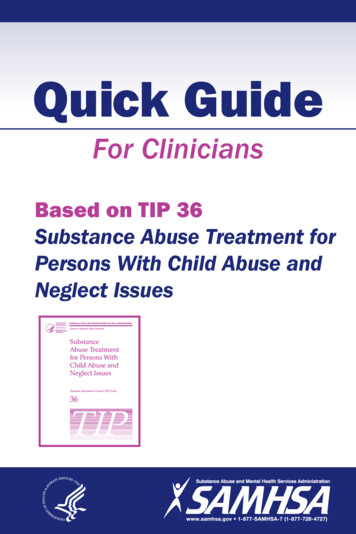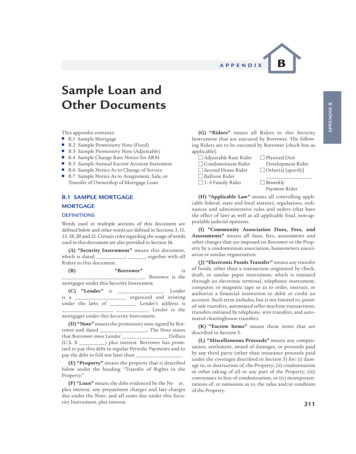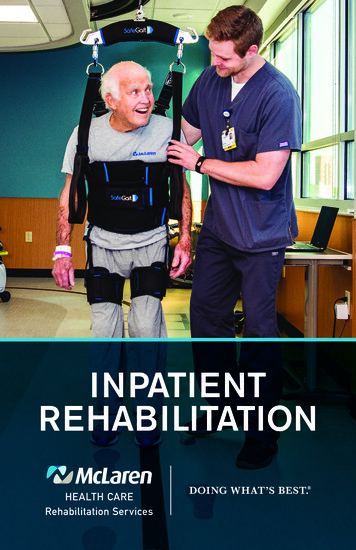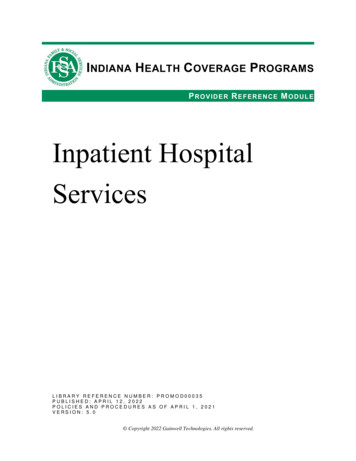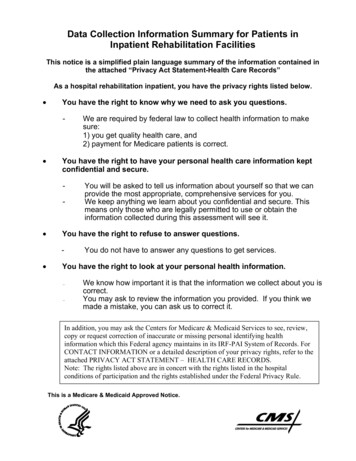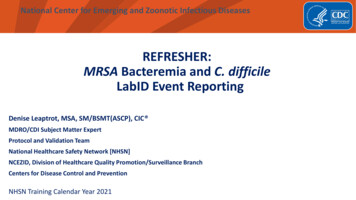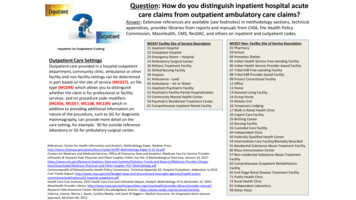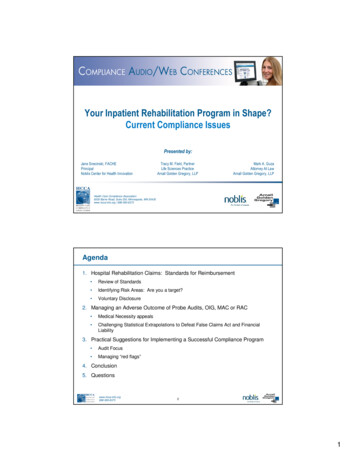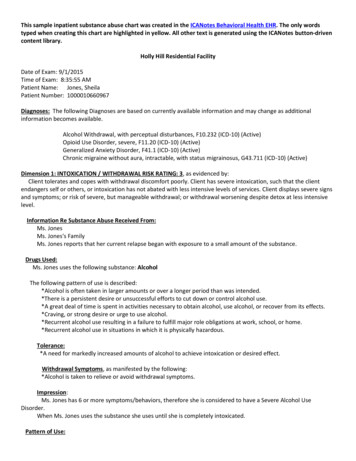
Transcription
This sample inpatient substance abuse chart was created in the ICANotes Behavioral Health EHR. The only wordstyped when creating this chart are highlighted in yellow. All other text is generated using the ICANotes button-drivencontent library.Holly Hill Residential FacilityDate of Exam: 9/1/2015Time of Exam: 8:35:55 AMPatient Name: Jones, SheilaPatient Number: 1000010660967Diagnoses: The following Diagnoses are based on currently available information and may change as additionalinformation becomes available.Alcohol Withdrawal, with perceptual disturbances, F10.232 (ICD-10) (Active)Opioid Use Disorder, severe, F11.20 (ICD-10) (Active)Generalized Anxiety Disorder, F41.1 (ICD-10) (Active)Chronic migraine without aura, intractable, with status migrainosus, G43.711 (ICD-10) (Active)Dimension 1: INTOXICATION / WITHDRAWAL RISK RATING: 3, as evidenced by:Client tolerates and copes with withdrawal discomfort poorly. Client has severe intoxication, such that the clientendangers self or others, or intoxication has not abated with less intensive levels of services. Client displays severe signsand symptoms; or risk of severe, but manageable withdrawal; or withdrawal worsening despite detox at less intensivelevel.Information Re Substance Abuse Received From:Ms. JonesMs. Jones's FamilyMs. Jones reports that her current relapse began with exposure to a small amount of the substance.Drugs Used:Ms. Jones uses the following substance: AlcoholThe following pattern of use is described:*Alcohol is often taken in larger amounts or over a longer period than was intended.*There is a persistent desire or unsuccessful efforts to cut down or control alcohol use.*A great deal of time is spent in activities necessary to obtain alcohol, use alcohol, or recover from its effects.*Craving, or strong desire or urge to use alcohol.*Recurrent alcohol use resulting in a failure to fulfill major role obligations at work, school, or home.*Recurrent alcohol use in situations in which it is physically hazardous.Tolerance:*A need for markedly increased amounts of alcohol to achieve intoxication or desired effect.Withdrawal Symptoms, as manifested by the following:*Alcohol is taken to relieve or avoid withdrawal symptoms.Impression:Ms. Jones has 6 or more symptoms/behaviors, therefore she is considered to have a Severe Alcohol UseDisorder.When Ms. Jones uses the substance she uses until she is completely intoxicated.Pattern of Use:
Ms. Jones's substance use is continuous. She uses multiple times a day.Ms. Jones has been using this substance intermittently for years.Ms. Jones reports having used this substance last, hours ago.Ms. Jones also uses the following substance: Oxycontin.Ms. Jones reports that her current relapse is, in part, due to stress. Details are as follows:When Ms. Jones uses substance the quantity used typically is about 10 pills per day. She administers thissubstance by mouth.Pattern of Use:Ms. Jones's substance use is episodic. She uses a few times a week.Ms. Jones has been using this substance since she was 32 after exposure to substance by her then boyfriend. Shelast used the substance about three days ago.Withdrawal Symptoms:Ms. Jones does describe at least one episode of withdrawal. The most recent occurred in the past year.Symptoms Included:*Agitation*Irritability*Joint Pain*Muscle Spasms*Sweating*Shaking/Tremors*Unable to SleepCIWA:The Clinical Institute Withdrawal Assessment for alcohol (revised) is a tool for monitoring alcohol withdrawal. Thefollowing subscale and total scores were today achieved by Ms. Jones:*Systolic Blood Pressure: 150*Diastolic Blood Pressure: 90*Pulse Rate: 100/min.*O2 Saturation: 97*Respiration Rate: 22/min.*Mild nausea is reported. (1 point)*A moderate tremor is visible when arms extended. (4 points)*Moderately anxious or guarded, so anxiety is inferred. (4 points)*Somewhat more than normal activity is present. (1 point)*No sweat is visible. (0 points)*Oriented. (0 points)*Mild itching, pins and needles, burning, or numbness. (2 points)*No auditory disturbances. (0 points)*Visual disturbances are denied. (0 points)*Severe headache. (5 points)Total Score: 15 (Scores of above 15 indicate severe withdrawal.) Actual score is 17.Dimension 2: BIOMEDICAL CONDITION/COMPLICATION RISK RATING: 2, as evidenced by:Client has some difficulty tolerating and coping with physical problems. Problems may interfere with recovery andmental health treatment. This patient may neglect care of serious problems.Psychotropic Med History:
Buspar: This medication was previously taken but is not currently taken. It was stopped because of its cost.Currently Prescribed Non Psychotropic Medications:Dilantin (compliant)Medical Screen:Potential Medical Emergency: (List all that are present):*Active withdrawal symptomsInfection or Disease:*Has had skin test for T.B. Details (date, results) are as follows:*Tested positive for T.B.*Chest X-ray completed annually.*Treatment for T.B. Completed: INH for six months.Dimension 3: MENTAL HEALTH RISK RATING: 3, as evidenced by:Client is functionally impaired during acute illness or from chronic symptoms, and illness interferes with treatment.Client has severe symptoms of emotional, behavioral, or cognitive problems, very poor impulse control and coping skills.Client may have had thoughts of suicide or harm to others, including a plan and the means to carry out the plan.Global Assessment of Individual Needs:Ms. Jones reports that she has the following:*Depression: Now*Sleep Difficulty: Now*Suicidal: Within the Past Month*Listening To Instruction: Now*Victim of Abuse: NeverTreatment History:Ms. Jones reports the following treatment history:Prior Psych Disorder:She has a history of anxiety symptoms. She suffered from anxiety symptoms when she was age 18. The episode ofanxiety symptoms lasted two years. She was treated.Dimension 4: TREATMENT ACCEPTANCE RISK RATING: 3, as evidenced by:Client displays inconsistent compliance, minimal awareness of either the client’s addiction or mental disorder, and isminimally cooperative.Defense Mechanisms: Ms. Jones minimizes the impact or severity of her illness.Motivation for Change: Ms. Jones appears poorly motivated for change.Addictive Behaviors: Ms. Jones describes drug problems, as is elsewhere described. Ms. Jones describes alcoholproblems, as are elsewhere described. Ms. Jones describes a history of an eating disorder.Self Help Groups Attended: NoneElopement Risk: Ms. Jones's Elopement Risk is considered to be low.Dimension 5: RELAPSE POTENTIAL RISK RATING: 4, as evidenced by:No awareness of the negative impact of mental health problems or substance abuse. No coping skills to arrest mentalhealth or addiction illnesses, or prevent relapse.Relapse History: Ms. Jones reports that this admission is relapse related.Relapse Triggers: Ms. Jones reports that current relapse began with her exposure to a small amount of alcohol.Relapse Frequency: She describes multiple previous relapses.Ms. Jones reports that her longest period of sobriety is about six months
Dimension 6: RECOVERY ENVIRONMENT RISK RATING: 2, as evidenced by:Client has minimal recognition and understanding of relapse and recidivism issues and displays moderatevulnerability for further substance use or mental health problems.Health and Behavior:Ms. Jones describes the following health and behavior practices: Tobacco:*Counseled regarding tobacco cessation*Counseling included consideration and discussion of nicotine replacement therapy.*Given advice about how to stop tobacco useLegal History:Ms. Jones's legal history is as follows:Arrests: Details are as follows: for DUI.Highest ASAM Risk Rating:RELAPSE POTENTIAL RISK RATING: 4No awareness of the negative impact of mental health problems or substance abuse. No coping skills to arrest mentalhealth or addiction illnesses, or prevent relapse.RECOMMENDATION:Send to Acute Inpatient Setting.Less intensive treatment failed or is considered unsafe or not feasible.RECOMMENDATION:Send to Acute Inpatient Setting.Serious deterioration in functioning requires 24 hr/day monitoring, for safety.RECOMMENDATION:Send to Acute Inpatient Setting.Medically monitored detoxification is needed.Joel Jones, LCSWElectronically SignedBy: Joel Jones, LCSWOn: 9/1/2015 8:36:04 AM
Holly Hill Residential FacilityDate of Exam: 9/1/2015Time of Exam: 9:35:55 AMPatient Name: Jones, SheilaPatient Number: 1000010660967CHEMICAL DEPENDENCY SPECIFIC BIO-PSYCHOSOCIAL ASSESSMENTHistory: Ms. Jones is a 37 year old woman. Her chief complaint is, "I am so anxious all the time that I cannotstop drinking."Circumstances Leading Up to Treatment: "I am a miserable mother to my twin girls and I really want to get mydrinking and anxiety under control."Information Re Substance Abuse Received From:Ms. Jones: Ms. Jones reports that her current relapse is, in part, due to stress. Details are as follows: "Iam always anxious and drink to calm my nerves"Drug Used:Ms. Jones uses the following substance: AlcoholThe following pattern of use is described:* Craving, or strong desire or urge to use alcohol.* Using larger amounts to get high.* Missing important events due to drinking.* Continued alcohol use despite having persistent or recurrent social or interpersonal problems causedor exacerbated by effects of alcohol.Tolerance:*A need for markedly increased amounts of alcohol to achieve intoxication or desired effect.Withdrawal Symptoms, as manifested by the following:*Alcohol is taken to relieve or avoid withdrawal symptoms.Impression:Ms. Jones has 6 or more symptoms/behaviors, therefore she is considered to have a Severe AlcoholUse Disorder.When Ms. Jones uses substance the quantity used is two bottles of wine per evening.Pattern of Use:Ms. Jones's substance use is continuous. She uses daily.Ms. Jones has been using this substance since she was a teenager.Ms. Jones reports having used this substance last night.Abused:Ms. Jones denies ever having been physically, emotionally, or sexually abused or sexually assaulted.
Anxiety Symptoms:Ms. Jones exhibits symptoms of anxiety. Her anxiety symptoms have been present for years.Ms. Jones describes the following anxiety symptoms:*Choking sensations are described*Blushes when feeling anxious in a social setting*Difficulty concentrating occurs*Feels embarrassment*Sensations of excessive muscular tension*Shortness of breathPast Psychiatric History:Dimension 3: MENTAL HEALTH RISK RATING: 3, as evidenced by:Client is functionally impaired during acute illness or from chronic symptoms, and illness interferes withtreatment. Client has severe symptoms of emotional, behavioral, or cognitive problems, very poor impulsecontrol and coping skills. Client may have had thoughts of suicide or harm to others, including a plan and themeans to carry out the plan.Global Assessment of Individual Needs:Ms. Jones reports that she has the following:*Depression: Now*Sleep Difficulty: Now*Suicidal: Within the Past Month*Listening To Instruction: Now*Victim of Abuse: NeverPrior Psych Disorder:She has a history of anxiety symptoms. She suffered from anxiety symptoms when she was age 18. Theepisode of anxiety symptoms lasted two years. She was treated.Withdrawal Symptoms:Ms. Jones does describe at least one episode of withdrawal. The most recent occurred in the past year.Symptoms Included:*Agitation*Irritability*Joint Pain*Muscle Spasms*Sweating*Shaking/Tremors*Unable to SleepCIWA:The Clinical Institute Withdrawal Assessment for alcohol (revised) is a tool for monitoring alcoholwithdrawal. The following subscale and total scores were today achieved by Ms. Jones:*Systolic Blood Pressure: 150*Diastolic Blood Pressure: 90*Pulse Rate: 100/min.*O2 Saturation: 97*Respiration Rate: 22/min.
*Mild nausea is reported. (1 point)*A moderate tremor is visible when arms extended. (4 points)*Moderately anxious or guarded, so anxiety is inferred. (4 points)*Somewhat more than normal activity is present. (1 point)*No sweat is visible. (0 points)*Oriented. (0 points)*Mild itching, pins and needles, burning, or numbness. (2 points)*No auditory disturbances. (0 points)*Visual disturbances are denied. (0 points)*Severe headache. (5 points)Total Score: 15 (Scores of above 15 indicate severe withdrawal.) Actual score is 17.Social/Developmental History:Dimension 4: TREATMENT ACCEPTANCE RISK RATING: 3, as evidenced by:Client displays inconsistent compliance, minimal awareness of either the client’s addiction or mentaldisorder, and is minimally cooperative.Defense Mechanisms: Ms. Jones minimizes the impact or severity of her illness.Motivation for Change: Ms. Jones appears poorly motivated for change.Addictive Behaviors: Ms. Jones describes drug problems, as are elsewhere described. Ms. Jones describesalcohol problems, as are elsewhere described. Ms. Jones describes a history of an eating disorder.Self Help Groups Attended: NoneElopement Risk: Ms. Jones's Elopement Risk is considered to be low.Dimension 5: RELAPSE POTENTIAL RISK RATING: 4, as evidenced by:No awareness of the negative impact of mental health problems or substance abuse. No coping skills toarrest mental health or addiction illnesses, or prevent relapse.Relapse History: Ms. Jones reports that this admission is relapse related.Relapse Triggers: Ms. Jones reports that current relapse began with her exposure to a small amount ofalcohol.Relapse Frequency: She describes multiple previous relapses.Ms. Jones reports that her longest period of sobriety is about six months.Dimension 6: RECOVERY ENVIRONMENT RISK RATING: 2, as evidenced by:Client has minimal recognition and understanding of relapse and recidivism issues and displays moderatevulnerability for further substance use or mental health problems.Health and Behavior:Ms. Jones describes the following health and behavior practices:Tobacco:*Counseled regarding tobacco cessation*Counseling included consideration and discussion of nicotine replacement therapy*Given advice about how to stop tobacco use
Legal History:Ms. Jones's legal history is as follows:Arrests: for DUI.Relationships/Marriage:Ms. Jones's relationship and/or marriage history is as follows:Times Married, Partnered:*Married onceThe current relationship has lasted:*More than ten yearsThe current relationship is described as:*Good, with a supportive partnerSupport System:Ms. Jones has the social support of the following:Spouse:*Highly supportiveA Friend or a Group of Friends:*Highly supportiveFamily History:Father thought to have alcoholism.Uncle treated as outpatient for alcoholism. This family member is paternally related.Cousin carries diagnosis of alcoholism. This family member is paternally related.Ms. Jones's family psychiatric history is otherwise negative. There is no other history of psychiatricdisorders, psychiatric treatment or hospitalization, suicidal behaviors or substance abuse in closely relatedfamily members.Medical History:Dimension 1: INTOXICATION / WITHDRAWAL RISK RATING: 3, as evidenced by:Client tolerates and copes with withdrawal discomfort poorly. Client has severe intoxication, such that theclient endangers self or others, or intoxication has not abated with less intensive levels of services. Clientdisplays severe signs and symptoms; or risk of severe, but manageable withdrawal; or withdrawal worseningdespite detox at less intensive level.Dimension 2: BIOMEDICAL CONDITION/COMPLICATION RISK RATING: 2, as evidenced by:Client has some difficulty tolerating and coping with physical problems. Problems may interfere withrecovery and mental health treatment. This patient may neglect care of serious problems.Psychotropic Med History:Buspar: This medication was previously taken but is not currently taken. It was stopped because of itscost.Currently Prescribed Non Psychotropic Medications:Dilantin (compliant)
Medical Screen:Potential Medical Emergency:*Active withdrawal symptomsInfection or Disease:*Has had skin test for T.B. Details are as follows:*Tested positive for T.B.*Chest X-ray completed annually.*Treatment for T.B. Completed: INH for six months.Mental Status Exam: Ms. Jones presents as guarded, irritable, casually groomed, and tense. She exhibitsspeech that is normal in rate, volume, and articulation and is coherent and spontaneous. Language skills areintact. Mood presents as normal with no signs of either depression or mood elevation. Her affect is congruentwith mood. Associations are intact and logical. There are no apparent signs of hallucinations, delusions, bizarrebehaviors, or other indicators of psychotic process. Associations are intact, thinking is logical, and thoughtcontent appears appropriate. Suicidal ideas are described but intentions are denied. Homicidal ideas orintentions are denied. Cognitive functioning and fund of knowledge are intact and age appropriate. Short andlong term memory are intact, as is ability to abstract and do arithmetic calculations. This patient is fullyoriented. Clinically, IQ appears to be in the above average range. Insight into problems appears to be poor.Judgment appears to be poor. There are signs of anxiety.Anxiety is present as evidenced by the following:*Restlessness*Trembling*Fidgety*Startle Response*SweatingMs. Jones is easily distracted. She is fidgety. Ms. Jones was sensitive to noise during the examination.Ms. Jones exhibits signs of withdrawal from a chemical. Signs of anxiety which appear to be secondary towithdrawal are present. She has been diuresing. She is tremulous.Diagnoses: The following Diagnoses are based on currently available information and may change asadditional information becomes available.Alcohol Withdrawal, with perceptual disturbances, 291.81 (F10.232) (Active)Opioid Use Disorder, severe, 304.00 (F11.20) (Active)Generalized Anxiety Disorder, 300.02 (F41.1) (Active)Migraine Specified, 346.90 (Active)Inventory:The Beck Anxiety Inventory: (A multiple choice self report monitoring test that measures the severity ofanxiety in adolescents and adults.)Ms. Jones scored between 30-63, indicating severe anxiety. Her exact score on the BAI is 50.Client Safety Plan:Ms. Jones has identified the following aspects of her behavior and staff support as significant in regardto her safety:Triggers That May Lead to Acting Out:
*Urges to Become Intoxicated (Use Substances):Warning Signs:*Physical Restlessness*Resistance to RulesWays of Acting Out:*Non Compliance with RulesCoping Skills:*Talking to Others*Activities for DistractionHelpful Staff Interventions:*Listening and Talking to Ms. Jones.Emotional Regulation Group is recommended for Ms. Jones.Relapse Prevention Group is recommended for Ms. Jones.Women's Intimacy Group is recommended for Ms. Jones.Ms. Jones describes the following 3 goals:1. Stay calm2. Meet new people3. Find a SponsorMs. Jones describes the following motivation for treatment: "I need to really be present as a parent formy kids." This is considered an internal motivation.NOTES AND RISK FACTORSHistory of Subst. AbuseKen Thompson, LCSWElectronically SignedBy: Ken Thompson, LCSWOn: 9/2/2015 9:11:26 AM
Holly Hill Residential FacilityDate of Exam: 9/3/2015Time of Exam: 9:35:55 AMPatient Name: Jones, SheilaPatient Number: 1000010660967COMPLETE EVALUATION: PSYCHIATRISTHistory: Ms. Jones is a 37 year old woman. Her chief complaint is, "My husband has told me I have to stopdrinking or he will take our children away."Information Re Substance Abuse Received From:Ms. JonesMs. Jones's FamilyMs. Jones reports that her current relapse is, in part, due to stress. Details are as follows:Drug Used:Ms. Jones uses the following substance: AlcoholThe following pattern of use is described:*Alcohol is often taken in larger amounts or over a longer period than was intended.*There is a persistent desire or unsuccessful efforts to cut down or control alcohol use.*Recurrent alcohol use resulting in a failure to fulfill major role obligations at work, school, or home.*Important social, occupational, or recreational activities are given up or reduced because of alcoholuse.Tolerance:*A need for markedly increased amounts of alcohol to achieve intoxication or desired effect.Withdrawal Symptoms, as manifested by the following:*Alcohol is taken to relieve or avoid withdrawal symptoms.Impression:Ms. Jones has 6 or more symptoms/behaviors, therefore she is considered to have a Severe AlcoholUse Disorder.Ms. Jones reports that she uses until she is completely intoxicated.Pattern of Use:Ms. Jones's substance use is continuous. She uses daily.Ms. Jones has been using this substance for years.Ms. Jones reports having used this substance last night.Anxiety Symptoms:Ms. Jones exhibits symptoms of anxiety. Her anxiety symptoms have been present for years.Ms. Jones describes the following anxiety symptoms:*Apprehensiveness*Avoidance*Difficulty concentrating*Sleep disturbance, she has early morning awakening*Trembling or shaking
Ms. Jones's symptoms are occurring daily. She reports previous episodes of anxiety symptoms. Ms.Jones's first episode of anxiety occurred at age 16. Ms. Jones has never been treated for anxiety symptoms.Severity is estimated to be high based on Ms. Jones's risk of morbidity without treatment and herdescription of interference with functioning.Problem Pertinent Review of Symptoms/Associated Signs and Symptoms: She convincingly denied symptomsof depression.Other Systems Reviews: There is no recent history of weight loss, fever, malaise, or other abnormalconstitutional symptoms. There is no history of disorder of muscle strength or tone, joint problems, ordisturbances of gait or station. Symptom reviews of all other systems are negative.Test Results: List of Test Results received today:Test(s) Performed on 9/3/2015:(1) Blood Alcohol Level: .50 % by Volume (1798-8)(2) Pregnancy Test: Negative (N/A)Past Psychiatric History:Withdrawal History:Ms. Jones's most recent episode of withdrawal occurred in the past year.Symptoms Included:*Agitation*Confused Speech*Diarrhea*Nausea/Vomiting*Unable to SleepPsychiatric Hospitalization:Ms. Jones has never been psychiatrically hospitalized.Outtatient Treatment:Has never received outpatient mental health treatment.Suicidal/Self Injurious:Ms. Jones describes having had self injurious thoughts.Medication Compliance:There is no history of medication noncompliance.Psychotropic Medication History:*Buspar: This medication is currently prescribed and has been taken for some weeks.Current dose is 5 mg. This medication is considered partially effective.Social/Developmental History:Health and Behavior:Ms. Jones describes the following health and behavior practices:
Tobacco:*Counseled regarding tobacco cessation*Counseling included consideration and discussion of nicotine replacement therapy*Given advice about how to stop tobacco useLegal History:Ms. Jones's legal history is as follows:Arrests: for DUI.Relationships/Marriage:Ms. Jones's relationship and/or marriage history is as follows:Times Married, Partnered:*Married onceThe current relationship has lasted:*More than ten yearsThe current relationship is described as:*Good, with a supportive partnerSupport System:Ms. Jones has the social support of the following:Spouse:*Highly supportiveA Friend or a Group of Friends:*Highly supportiveFamily History:Father thought to have alcoholism.Uncle treated as outpatient for alcoholism. This family member is paternally related.Cousin carries diagnosis of alcoholism. This family member is paternally related.Ms. Jones's family psychiatric history is otherwise negative. There is no other history of psychiatricdisorders, psychiatric treatment or hospitalization, suicidal behaviors or substance abuse in closely relatedfamily members.Medical History:Medical Screen:Potential Medical Emergency:*Active withdrawal symptomsInfection or Disease:*Has had skin test for T.B. Details are as follows:*Tested positive for T.B.*Chest X-ray completed annually*Treatment for T.B. Completed: INH for six monthsAdverse Drug Reactions:There is no known history of adverse drug reactions.Allergies:There are no known allergies.
Current Medical Diagnoses:Cardiovascular:*HypertensionCurrent Medications:*Lasix and KCL supplement.Cardiac Disclaimer:There is no family history of early death due to cardiac arrhythmia or conduction defect or other relatedcardiac issues.Mental Status Exam: Ms. Jones presents as calm, distracted, casually groomed, but appears anxious. Sheexhibits speech that is normal in rate, volume, and articulation and is coherent and spontaneous. Languageskills are intact. Mood presents as normal with no signs of either depression or mood elevation. Affect isappropriate, full range, and congruent with mood. Associations are intact and logical. There are no apparentsigns of hallucinations, delusions, bizarre behaviors, or other indicators of psychotic process. Associations areintact, thinking is logical, and thought content appears appropriate. Homicidal ideas or intentions are denied.Cognitive functioning and fund of knowledge are intact and age appropriate. Short and long term memory areintact, as is ability to abstract and do arithmetic calculations. This patient is fully oriented. Clinically, IQappears to be in the above average range. Insight into problems appears to be poor. Judgment appears to bepoor.There are signs of anxiety:*Restlessness*Irritability*Fidgety*Startle ResponseMs. Jones is fidgety. She is easily distracted. Ms. Jones is restless. She made poor eye contact during theexamination. Ms. Jones exhibits signs of withdrawal from a chemical. Agitation, seemingly secondary towithdrawal, is present. She is diaphoretic. She is tremulous.Vital SignsSitting blood pressure is 152 / 67. Sitting pulse rate is 72. Pulse is regular. Respiratory rate is 21 per minute.Temperature is 98.4 degrees F. Muscle strength, muscle tone, gait and station are all normal.Diagnoses: The following Diagnoses are based on currently available information and may change asadditional information becomes available.Alcohol Withdrawal, with perceptual disturbances, 291.81 (F10.232) (Active)Opioid Use Disorder, severe, 304.00 (F11.20) (Active)Generalized Anxiety Disorder, 300.02 (F41.1) (Active)Migraine Specified, 346.90 (Active)Clinical Summary:RISK ASSESSMENT: SUICIDE/VIOLENCEHistory of Risk Factors:Ms. Jones has a history of alcohol or substance abuse.Ms. Jones has a history of Severe Anxiety or Panic Attacks.
Current Risk Factors:Ms. Jones is experiencing severe anxiety or panic.There is impaired impulse control.Protective Factors:Religious beliefsGood family supportFeeling of responsibility to children, family or other loved entities.Suicide Risk:Based on the above risk factors, Ms. Jones's risk of suicide is considered LOW. Fleeting thoughts may bepresent but there is no intention or plan.Violence Risk:Based on the risk factors reviewed, Ms. Jones's current risk of violence is considered VERY LOW orabsent. There are no homicidal or aggressive or self injurious intentions or ideation.Instructions / Recommendations / Plan:A high residential program is recommended, as patient is not in need of intensive 24 hour monitoring butneeds 24 hour supervision.Encourage all activitiesUnit MeetingsWard ActivitiesPsychopharmacologyAntabuse Teaching:The effective use of Antabuse as a deterrent to impulsive drinking was explained in detail today. Patient is toldthis agent is safe to use with after-shaves, lotions, soaps and mouthwash (unless ingested). It is reinforced thatAntabuse is an excellent deterrent against impulsive intake of alcohol. It is also explained that Antabuse can beespecially effective if the patient has a history of using ETOH as a "portal of entry" for other substances butwould not otherwise abuse other substances if not primed with alcoholStart Antabuse 500 mg. PO QAM (ETOH Deterrent)Increase Buspar 10 mg PO BID (Anxiety)Start Ambien CR 6.25 mg PO QHS PRN (Insomnia)Start Klonopin 2 mg PO BID x2 days (Withdrawal)Then Klonopin 1 mg PO QAM x2 days (Withdrawal)Then Klonopin 0.25 mg PO QAM x1 day (Withdrawal)Then Stop Klonopin 0.25 mg PO QAM (Withdrawal)Notes and Risk FactorsHistory of Subst. AbuseNo known history of adverse drug reactions99223AI Initial Hosp. / In Pt CareTom Jones, MDElectronically SignedBy: Tom Jones, MDOn: 9/3/2015 9:47:55 AM
Holly Hill Residential FacilityDate of Exam: 9/4/2015Time of Exam: 11:35:55 AMPatient Name: Jones, SheilaPatient Number: 1000010660967CHEMICAL DEPENDENCY INITIAL NUSRING EVALUATIONHistory: Ms. Jones is a 37 year old woman. Her chief complaint is, "I cannot seem to stop drinking."Information Re Substance Abuse Received From:Ms. Jones: Ms. Jones reports that her current relapse began with exposure to a small amount of thesubstance. Ms. Jones reports that her current relapse is, in part, due to stress. Details are as follows:Drug Used:Ms. Jones uses the following substance: AlcoholThe following pattern of use is described:*Alcohol is often taken in larger amounts or over a longer period than was intended.*There is a persistent desire or unsuccessful efforts to cut down or control alcohol use.*A great deal of time is spent in activities necessary to obtain alcohol, use alcohol, or recover from itseffects.*Craving, or strong desire or urge to use alcohol.*Continued alcohol use despite having persistent or recurrent social or interpersonal problems causedor exacerbated by effects of alcohol.*A need for markedly increased amounts of alcohol to achieve intoxication or desired effect.Withdrawal Symptoms, as manifested by the following:*The characteristic withdrawal syndrome for alcohol.Impression:Ms. Jones has 6 or more symptoms/behaviors, therefore she is considered to have a Severe AlcoholUse Disorder.When Ms. Jones uses substance the quantity used is two bottles of wine per evening.Pattern of Use:Ms. Jones's substance use is continuous. She uses daily.Ms. Jones has been using this substance intermittently for years.Ms. Jones reports having used this substance last, hours ago.Past Psychiatric History:Wi
Ms. Jones reports having used this substance last, hours ago. Ms. Jo nes also uses the following substance: Oxycontin. Ms. Jones reports that her current relapse is, in part, due to stress. Details are as follows: When Ms. Jones uses substance the quantity used typically is abou t 10 pills per day. She administers this substance by mouth.



